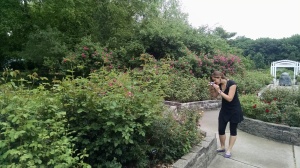I have a new paper out! You can read it: Predicting plant attractiveness to pollinators with passive crowdsourcing.1

Just a human engaging in a normal human leisure activity.
A while back, my colleague, Doug Landis, was searching the web for pictures of flowers for a project about native plants, and noticed that some pictures of flowers he looked at frequently captured insect visits. He got to wondering- do the bees we occasionally observe in this sort of photo have…meaning?
He asked me what I thought of his observation- and could we test it. Are flowers that are photographed more frequently with insects, indeed, more attractive to insects? This idea got me pretty excited. If you’ve been following me for long, you know I delight in finding data and patterns in places we don’t normally think to look. It’s kind of my *thing.* And through the course of everyday activities, humans passively collect data about the world around them. It seems to reason that common leisure activities -like photographing and sharing pictures of flowers– could potentially capture ecological phenomena- in this case, the visitation rates of pollinators to flowers of different species.
So we developed a method to test our hypothesis. Using a technique we termed ‘passive crowdsourcing,’ we searched Google Images for pictures of blooms of 43 common flowering plants that are native to Michigan, and identified insects that were visible visiting the flowers in the photos. We then compared these observations to visitation rates observed in controlled experimental trials using these same plants. We found that we could predict how often a flower was visited by wild bees by the number of visits we observed in the internet images, although relationships were less clear for honey bees and bee mimicking flies. Patterns were strongest for flowers that bloom in late summer, when more bees tend to be around in our area.
We’re pretty excited to see how passive crowdsourcing can be applied in the future. This method could be used by scientists to make predictions about other ecological phenomena that may be documented by human use of the web. Essentially anything that people tend to photo-document with any frequency could be capturing data, and could potentially help unlock the scientific mysteries of the future!2
—
1. And it’s all completely open access, because that’s how I roll. Our raw data and code is available here.
2. If anyone asks you to put down your phone and stop taking pictures of everything, you can gently explain how you’re advancing science. 🙂

Neat stuff! I’ve often wondered this…can you turn it around and say look at the photos on bugguide to predict which insects will visit which flowers based on the frequencies of those species specific interactions? (Anecdotally I see a lot of photos of insects on thistle flowers, and from data I know that thistles are highly attractive and generalist, but I don’t know how much of the perceived photo relationship is bias.)
I am always amazed by how often photographs of flowers reveal insects lurking inside. You often don’t notice the insects until for look at the photograph on a computer. Something I like to do – being a bit obsesdive😊- is to take lots and lots of images of individual flowers of the same species. It’s fun to see how many different insects turn up and it can also reveal interesting associations.
I have blogged about this;
Great paper! You might also be interested in our paper that came out a few weeks ago in Methods in Ecology and Evolution – Just Google it: assessing the use of Google Images to describe geographical variation in visible traits of organisms
http://onlinelibrary.wiley.com/doi/10.1111/2041-210X.12562/full
Here is some media coverage about it too:
http://www.theguardian.com/environment/2016/may/11/google-images-as-good-as-fieldwork-for-studying-animal-colour
We demonstrated that Google Images could be used to accurately describe the spatial patterns of visable phenotypes. We also developed a web app that might help you with some of your research.
Very cool idea! Have a look at our paper which also looks into using Google Images to answer ecological questions: http://onlinelibrary.wiley.com/wol1/doi/10.1111/2041-210X.12562/abstract
We also developed a tool (https://morphs.io) which allows users to fill in a survey form per image from Google Images.
Awesome! I’ll take a look!
Great!